Is the new-gen CB Unicorn as much of a legend as the fabled original?
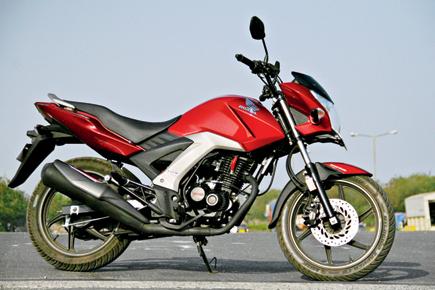
Hard as the opponents may have tried with jazzy styling and bloated performance figures, the conservative-looking yet impeccably engineered Unicorn has held sway in the 150cc segment. A no-nonsense motorcycle, offering unparalleled refinement and reliability, with arguably segment-defining ride and handling, the CB Unicorn still had a waiting period of three months prior to the introduction of the new-generation model. The CB Unicorn 160, as the latest incarnation of the immensely popular motorcycle is known as, then, has big shoes to fill. Does it carry forth its forebear’s legendary legacy with reassurance? We find out as we take the all-new version of this storied machine out for a thorough test on Mumbai's streets.
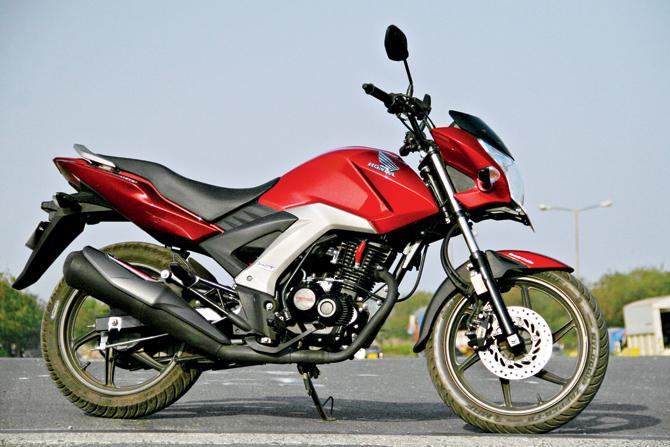
ADVERTISEMENT
Design and Styling
The design of the new Unicorn is more evolutionary than revolutionary. Rather than jumping on to the aggressive-styling bandwagon, which is somewhat preposterous for the relatively modest 150cc segment, Honda has taken a cautious route by adding a hint of youthfulness while still retaining the understated brief for the motorcycle.
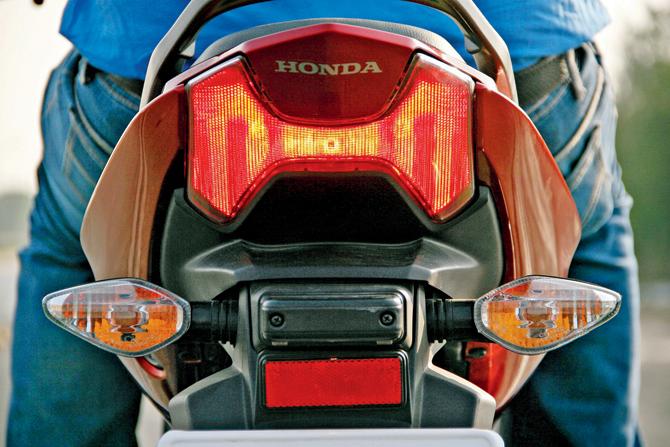
Unique H-shaped LED tail-lamp has a homogenous glow, and evokes a mixed response aesthetically
The CB Unicorn has a wide appeal, finding favour among youngsters and even the mature audience -- executives who commute to work, and want something substantial and powerful as their ride. So the new Unicorn gets some youthful elements, though the overall expression is still understated.
The headlamp is new, though it doesn’t gel well with the rest of the theme. The tank has grown more muscular and now receives angular side cowls. The tank on the 160 Unicorn also features a new 3D chrome-finished Honda Wing emblem. A two-tone side panel features a troika of fins, along with a cavity in its lower portion. Those details, however, don’t get prominently highlighted owing to the black colour of the plastic.
Unlike the rather angular, edgy elements up front, the rear panel adopts an organic, fluid shape and looks nice in isolation, though it doesn’t blend very well with the overall design. The grab rails get a satin finish. The new Unicorn gets its compact, trendy saree guard from the CB Trigger, which looks quite good.
At the rear, the new Honda motorcycle gets a homogenously lit H shaped LED lamp. The new motorcycle also gets a dedicated illumination source for the registration plate.
The new Unicorn adopts new elements, without looking radically different from its predecessors. With its inoffensive design and humble demeanour the Unicorn manages to retain its visual identity. It’s not a head turner, and some elements don’t quite blend in too well. Overall proportions, though, are well-balanced, and the CB Unicorn 160 would still manage to appease its target audience -- those who merit function over form and have a subtle taste.
Instruments, switchgear and ergonomics
The new Unicorn gets an all-digital instruments unit comprising a speedometer, tachometer, odometer, two trip meters, fuel gauge, clock, and tell-tale indicators. The backlight on the display is quite bright and there are no visibility issues even in harsh sunlight.
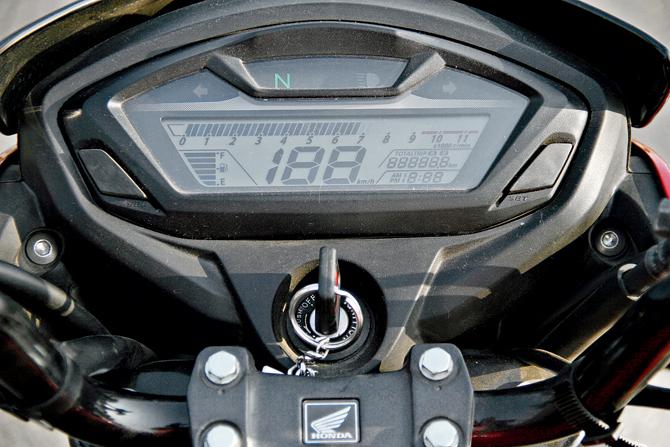
New all-digital instrument console has tacho, speedo, twin-trip meters, fuel guage and other tell-tale lights
The switchgear is minimalistic, though the quality of the switches is quite good. It’s built to last, finished well and looks neat except for a couple of exposed wires. The set-up misses out on an engine kill switch which we believe is a big omission for a new generation motorcycle. The handlebar grips are made of soft-to-touch, quality rubber and feel nice to hold with their slim shape.
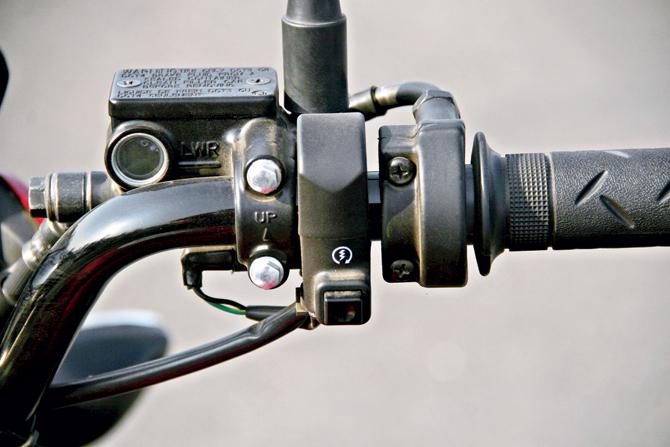
Switchgear is minimalistic, but of good quality and is built to last. We don’t like those wires peeping out of their casings though. Pics/Amit Chhangani
The new Unicorn also retains the friendly riding position of its forerunner. Ergonomics are comfort oriented and don’t have any sporty pretensions. The foot-pegs are forward set, allowing for a stress free riding position, while also offering reasonable buffer for those corner-carving runs up the hill over a weekend. Comfortable, friendly ergonomics make this new Honda an ideal city tool that can also be easily used for long highway hauls.
Engine, performance and handling
The earlier-gen Unicorn was known for its silky smooth, refined engine which was built to last a lifetime. In its latest iteration, the Unicorn gets an all-new engine with more cubic capacity, more power and a somewhat altered character.
Let’s talk numbers first. The 162.7cc engine on the new Unicorn produces 14.5bhp of power (1.5 bhp more than the previous model) at 8,000 rpm. Torque figures are rated at a healthy 14.61 Nm @ 6,000 rpm (1.77 Nm more). In addition, the new Unicorn has shed 11 kg of weight, improving its power to weight ratio and resultantly enhancing performance. The tachometer on the motorcycle is redlined at a high 9,250 rpm with reading going well above 11,000 rpm. Labelled with Honda Eco Technology tag, the motorcycle’s ARAI fuel efficiency figure stands at 62 kmpl.

All new 162.7-cc engine offers punchy performance and emanates a throaty sound
The new engine doesn’t sound as buttery smooth as the unit it replaces. That’s no accident, though, the engine has been engineered to emanate a slightly raspier note, probably to appease the enthusiasts. And we’re confident that it’s deliberate because none of that aural gruffness translates into vibes on the foot-pegs or handlebar. The throatier sound aside, the engine is smooth as ever, and loves getting revved its peak without the slightest of protest.
There is ample low to mid-range torque on offer to make the new motorcycle a very capable city commuter. The Unicorn 160 can handle slow moving city traffic with aplomb without requiring the rider to shift often.
Once it attains higher revs, the new Unicorn delivers performance which is dependable and punchy, if not segment leading. The top gear is relatively tall which is ideal for highway cruising while the motor revs up easily in lower gears for quick through city traffic.
Honda has introduced its combined braking system (CBS) to the Unicorn, which applies brakes to both wheels to drop the anchors effectively. There is a 240-mm disc brake up front and a 130-mm drum with CBS at the rear. Wrapping the wheels are MRF Nylogrip Zapper tubeless tyres, which though not exceptional, are reasonably gluey for everyday use. The suspension on the new motorcycle is slightly stiffer than the previous gen model. The mono-shock rear unit is very well damped, though it feels slightly more taut than desirable for a solo rider. It feels more absorbent with a pillion rider occupying the rear seat. The chassis is sorted as ever and the Unicorn, feels rock solid in a straight line, even while doing triple digit speeds. The balanced chassis also allows for effortless, natural corner carving -- making the Unicorn 160 and extremely enjoyable and forgiving motorcycle around bends. The slightly stiff suspension, which may be a little bothersome on broken roads, comes across as a blessing as one explores the motorcycle’s dynamic ability around a set of corners. Verdict
With the new Unicorn, Honda has taken a measured approach for upgrading its decade old 150-cc crusader. A bigger engine with more power and a slightly sportier character equips it to fend off the challenge thrown in by the new contenders. Honda has also made stylistic changes to make it appeal a bit more to the youth, though we don’t believe the approach has worked too well. The bike retains its rider-friendly, ambidextrous demeanour and those looking for a practical, reasonably fast motorcycle would love Honda for that. At R74,414 for the CBS variant (ex-showroom, Delhi), the Unicorn 160 does not come cheap but over the years, the model has proved that it's way ahead of the competition not just in terms of quality, engineering and durability, but also cost of ownership. It’s a no-nonsense motorcycle with no facades, but can teach the pretenders a thing or two about performance if the need arises. Look no further if an ambidextrous, all-purpose motorcycle is what you are looking for in the sub-200cc segment.
Technical specs
engine -- Single-cylinder air-cooled four-stroke Engine
Cubic Capacity (cc) -- 162.71
Power (PS) @ RPM -- 14.7@8,000
Torque (Nm) @ RPM -- 14.6@6,000
Transmission -- Five-speed manual transmission
Fuel Tank Capacity (Litre) -- 12
Kerb Weight (kg) -- 135
 Subscribe today by clicking the link and stay updated with the latest news!" Click here!
Subscribe today by clicking the link and stay updated with the latest news!" Click here!







